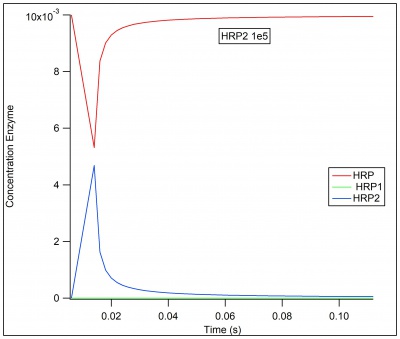Difference between revisions of "Gepasi"
| Line 45: | Line 45: | ||
[[File:hrp_1e6_graph.jpg|400px|thumb|left|Figure 3. Graph of the HRP phases with the HRP2 rate increased to 1e^6.]] | [[File:hrp_1e6_graph.jpg|400px|thumb|left|Figure 3. Graph of the HRP phases with the HRP2 rate increased to 1e^6.]] | ||
| − | |||
| − | |||
| − | |||
| − | |||
| − | |||
| − | |||
| − | |||
| − | |||
| − | |||
| − | |||
| − | |||
| − | |||
| − | |||
| − | |||
| − | |||
| − | |||
| − | |||
| − | |||
| − | |||
| − | |||
| − | |||
| − | |||
| − | |||
| − | |||
| − | |||
| − | |||
| − | |||
| − | |||
| − | |||
| − | |||
| − | |||
Revision as of 14:29, 20 June 2019
Gepasi is a software package used to model biochemical systems on Windows. Gepasi simulates the kinetics of the systems and provides many analysis tools for the data.
Procedure
1) Rename title.
2) Add reactions.
3) Make sure the number of metabolites matches the reactions.
4) Click "kinetics."
5) Choose "mass action (reversible)."
6) Enter k1 and k2 values for each reaction.
7) Choose "metabolite."
8) Enter concentrations for each metabolite.
9) Click "time course" choose run.
To Save Data
1) Click the task tab.
2) Choose "edit."
3) Add metabolites and time.
4) Rename the file time course.
5) Click "run."
Helpful Tips
If your extracted data is not showing points for the entire run time you have selected, increase the number of points in Gepasi under the "Task" tab.
Additionally, if you are putting the data into a wavemetric software like IGOR, and your waves are downloading as 2 dimensional waves, append the waves to the table and edit them from there. Editing in the table will change the waves everywhere in the software.
Example Graphs


